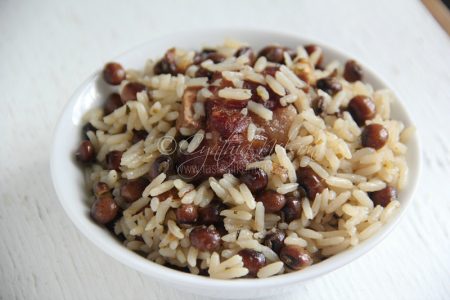Hi Everyone,
Several years ago while standing in the cashier line at one of the supermarkets here in Barbados, a man (tourist) standing immediately behind me pointed to the small tray I  had just put on the cash belt and asked what it was. I explained that they were salted pigtails. He nodded and asked, “Why are they sold in such small quantities?” (Pre-packaged trays of pigtails mostly have 2 pigtails, some may have 3), I explained to the visitor that the brine-cured pigtails are used as salt to season and flavour food, particularly Rice and Peas, hence the small quantity.
had just put on the cash belt and asked what it was. I explained that they were salted pigtails. He nodded and asked, “Why are they sold in such small quantities?” (Pre-packaged trays of pigtails mostly have 2 pigtails, some may have 3), I explained to the visitor that the brine-cured pigtails are used as salt to season and flavour food, particularly Rice and Peas, hence the small quantity.

The late Barbadian poet, author, and writer, Austin Clarke’s food memoir, Pigtails ‘N Breadfruit (Randle 2000) was an education for me when it came to the use of salted pigtails in Bajan cuisine. While I had spent years eating salt meat in Cook-up Rice as part of the meat component of the dish, I’d never used it as the seasoning for a dish. And the key to proper Bajan Rice and Peas, is not only a generous amount of peas in the rice but the seasoning (salting) of the dish with a piece of salt meat – mostly pig tails and to a lesser extent, salt beef.
Just as one is careful to add just enough salt to taste, to a pot when cooking, the same attention is paid when determining the quantity of salt meat to add to a pot of rice and peas to season the dish. While salt meat (pigtails or beef) if being cooked as the meat component of a dish, is usually soaked and boiled to remove the excess salt, that is not the case when cooking salt meat for Rice and Peas, the pigtails are jointed into 2-inch pieces, quickly rinsed under tap water and added directly to the pot to cook first with the peas, and later, with the rice when added. The salt meat, through the process of boiling in the first stages of cooking the peas, and then the rice, releases its salinity in the cooking liquid thereby seasoning (adding taste) to the rice and peas. The bits of fat surrounding the pigtails release oil into the pot and that too helps season and add flavour to a pot of Rice and Peas.
Once cooked, the 2 to 3 pieces of now softened cured meat, free of excess salt, are always sought after. Having just a piece of the tender salt meat with some of the rice and peas is a meal in itself. Often considered the prize in the rice (because of how few pieces there are), the cook when sharing food can choose whom she/he wants to give the prize to, or keep it for him/herself. A few weeks ago, while visiting the home of a family friend, I was asked to dish the Rice and Peas from the pot into a serving dish. The matriarch of the home and I chatted as I spooned the rice into the bowl. I hit upon the prize, looked up, and our eyes met, she laughed at me and said, “Go on, you take it, I had a piece already.” It would have been inappropriate for me to determine on my own that I was going to take the prize in the rice. If I was in my home and I had cooked, then the power to share or not, would have been mine.
The amount to salted pigtails to add to a pot of rice and peas is dependent on the quantity you are making. You do not add so much that you over season the food, in this case, it is better to under-season especially since the rice is likely to be served with some sort of meat, poultry or seafood sauce/gravy. What I have worked out (feel free to use as a guide) is that 1 whole pigtail about 6 – 7 inches long, cut into 3 – 4 pieces, perfectly seasons 2 cups of raw rice and 3 cups of rehydrated peas cooked together in a pot of rice and peas.
I make my Rice and Peas a little different than Barbadians do, I sauté finely chopped onions and minced fresh thyme along with the pigtails to flavour the oil setting the foundation for the dish. Once the onions are softened, the drained peas are added along with water to boil for several minutes to release the salt from the pigtails before covering the pot to pressure the peas. When the peas is cooked but still whole, washed rice is added, along with a measured amount of boiling water to cook the rice using the absorption method. If I am making it to entertain, I use stock or fresh coconut milk as my cooking liquid. Most Barbadians boil the peas with the pigtails until soft and cooked through, then they add lots of fresh thyme along with the rice and water to cook, using the absorption method.
The Scene will be on August holiday for the month so there will be no Tastes Like Home column for the next 4 weeks, but you can catch up with me on the blog: www.tasteslikehome.org or on Facebook: www.facebook.com/tasteshome. We’ll meet up here again on Saturday, September 2.








